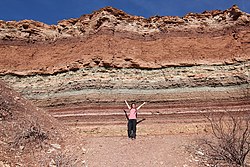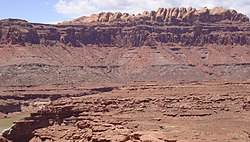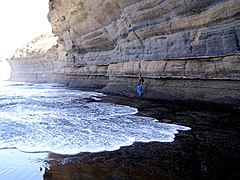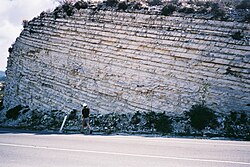Слој (геологија) — разлика између измена
Нема описа измене |
. |
||
| Ред 1: | Ред 1: | ||
{{short description|Слој седиментне стене или земљишта са унутрашњим конзистентним карактеристикама}} |
|||
| ⚫ | '''Слој''' је [[геологија|геолошко]] тело, изграђено од мање или више истоветног материјала. То је основни елемент [[седиментне стене|седиментих стена]], настао као резултат једне континуиране фазе [[седиментација|седиментације]], чији је првобитни положај хоризонталан или субхоризонталан. Од [[подина|подинског]] и [[повлата|повлатног]] слоја издвојен је површима слојевитости, које представљају границе механичког дисконтинуитета. Управно растојање између доње и горње површи слојевитости је дебљина слоја. Према дебљини, слојеви се деле на: |
||
[[Image:Quebrada de Cafayate, Salta (Argentina).jpg|250px|thumb|Страта у [[Salta province|Салти]] ([[Аргентина]]).]] |
|||
*лиске (испод 5 -{mm}-) |
|||
[[Image:Stratum.JPG|250px|thumb|Голденвилски слојеви у каменолому у [[Bedford, Nova Scotia|Бедфорду]], Канада. Ово су морски седименти [[Middle Cambrian|средњег камбријума]]. Ова формација покрива преко половине [[Nova Scotia|Нове Шкотске]] и забележена је као<br> 8.800 m (29.000 ft) дебљине у неким областима. ]] |
|||
*плоче (од 5 до 50 -{mm}-) |
|||
*слојеве (5 до 60 -{cm}-) |
|||
*банке (дебљина већа од 60 -{cm}-). |
|||
| ⚫ | '''Слој''' је [[геологија|геолошко]] тело, изграђено од мање или више истоветног материјала. То је основни елемент [[седиментне стене|седиментих стена]], настао као резултат једне континуиране фазе [[седиментација|седиментације]], чији је првобитни положај хоризонталан или субхоризонталан.<ref name="Salvador1994a">Salvador, A. ed., 1994. ''International stratigraphic guide: a guide to stratigraphic classification, terminology, and procedure. 2nd ed.'' Boulder, Colorado, The Geological Society of America, Inc., 215 pp. {{ISBN|978-0-8137-5216-7}}</ref> Од [[подина|подинског]] и [[повлата|повлатног]] слоја издвојен је површима слојевитости, које представљају границе механичког дисконтинуитета. Управно растојање између доње и горње површи слојевитости је дебљина слоја. Према дебљини, слојеви се деле на: лиске (испод 5 -{mm}-), плоче (од 5 до 50 -{mm}-), слојеве (5 до 60 -{cm}-) и банке (дебљина већа од 60 -{cm}-). |
||
| ⚫ | Слој је у простору одређен својим [[елементи пада|елементима пада]], [[азимут]]ом и [[падни угао|падним углом]]. Врло је важно познавати елементе пада слоја, због одређивања елемената [[набор]]а које слојеви изграђују. Тако је, у теренима који имају сложен тектонски склоп, важно одредити да ли су слојеви у преврнутом или нормалном положају. То се најчешће ради на основу испитивања карактеристика примарних [[планара]], при чему се најчешће користе следећи критеријуми: биостратиграфско простирање, [[градациона слојевитост]], критеријум односа [[кливаж]]а према слојевитости, испитивање седиментних структура, анализа [[набор]]а нижег реда, итд. |
||
| ⚫ | Слој је у простору одређен својим [[елементи пада|елементима пада]], [[азимут]]ом и [[падни угао|падним углом]]. Врло је важно познавати елементе пада слоја, због одређивања елемената [[набор]]а које слојеви изграђују. Тако је, у теренима који имају сложен тектонски склоп, важно одредити да ли су слојеви у преврнутом или нормалном положају. То се најчешће ради на основу испитивања карактеристика примарних [[планара]], при чему се најчешће користе следећи критеријуми: биостратиграфско простирање, [[градациона слојевитост]], критеријум односа [[кливаж]]а према слојевитости, испитивање седиментних структура, анализа [[набор]]а нижег реда, итд.<ref name="NeuendorfOthers2005a">Neuendorf, K.K.E., Mehl, Jr., J.P., and Jackson, J.A. , eds., 2005. ''Glossary of Geology'' 5th ed. Alexandria, Virginia, American Geological Institute. 779 pp. {{ISBN|0-922152-76-4}}</ref> |
||
{{клица-геологија}} |
|||
== Карактеристике == |
|||
{{rut}} |
|||
[[Image:SEUtahStrat.JPG|thumb|250px|The [[Permian]] through [[Jurassic]] strata in the [[Colorado Plateau]] area of southeastern [[Utah]] demonstrate the principles of [[stratigraphy]]. These strata make up much of the famous prominent rock formations in widely spaced protected areas such as [[Capitol Reef National Park]] and [[Canyonlands National Park]]. From top to bottom: Rounded tan domes of the [[Navajo Sandstone]], layered red [[Kayenta Formation]], cliff-forming, vertically jointed, red [[Wingate Sandstone]], slope-forming, purplish [[Chinle Formation]], layered, lighter-red [[Moenkopi Formation]], and white, layered [[Cutler Formation]] sandstone. Picture from [[Glen Canyon National Recreation Area]], Utah.]] |
|||
Typically, a stratum is generally one of a number of parallel layers that lie one upon another to form enormous [[thickness (geology)|thicknesses]] of strata.<ref name="Salvador1994a"/> The bedding surfaces (bedding planes) that separate strata represent episodic breaks in deposition associated either with periodic [[erosion]], cessation of deposition, or some combination of the two.<ref name="DaviesOthers2021a">Davies, N.S., and Shillito, A.P. 2021, ''True substrates: the exceptional resolution and unexceptional preservation of deep time snapshots on bedding surfaces.'' ''Sedimentology.'' published online 22 May 2021, doi: 10.1111/sed.12900.</ref><ref name="DaviesOthers2018a">Davies, N.S., and Shillito, A.P. 2018, ''Incomplete but intricately detailed: the inevitable preservation of true substrates in a time-deficient stratigraphic record.'' ''Geology'', 46, 679–682.</ref> Stacked together with other strata, individual stratum can form composite stratigraphic units that can extend over [[1 E11 m²|hundreds of thousands of square kilometers]] of the [[Earth]]'s surface. Individual stratum can cover similarly large areas. Strata are typically seen as bands of different colored or differently structured material exposed in [[cliff]]s, [[road]] cuts, [[quarry|quarries]], and [[river]] banks. Individual bands may vary in [[thickness (geology)|thickness]] from a few [[millimeter]]s to several [[meter]]s or more. A band may represent a specific mode of [[Deposition (sediment)|deposition]]: river [[silt]], beach [[sand]], coal [[swamp]], [[sand dune]], [[lava]] bed, etc. |
|||
== Врсте стратума == |
|||
In the study of rock and sediment strata, geologists have recognized a number of different types of strata, including ''bed'', ''flow'', ''band'', and ''key bed''.<ref name="Salvador1994a"/><ref name="MurphyOthers1999a"/> A bed is a single stratum that is lithologically distinguishable from other layers above and below it. In the classification hierarchy of sedimentary lithostratigraphic units, a bed is the smallest formal unit. However, only beds that are distinctive enough to be useful for stratigraphic correlation and geologic mapping are customnarily given formal names and considered formal lithostratigraphic units. The volcanic equivalent of a bed, a flow, is a discrete extrusive volcanic stratum or body distinguishable by texture, composition, or other objective criteria. As in case of a bed, a flow should only be designated and named as a formal lithostratigraphic units when it is distinctive, widespread, and useful for stratigraphic correlation. A band is a thin stratum that is distingushiable by a distinctive lithology or color and is useful in correlating strata. Finally, a key bed, also called a ''marker bed'', is a well-defined, easily identifiable stratum or body of strata that has sufficiently distinctive characteristics, such as lithology or fossil content, to be recognized and correlated during geologic field or subsurface mapping.<ref name="Salvador1994a"/><ref name="MurphyOthers1999a">Murphy, MA., and Salvador, A., 1999. [https://www.episodes.org/journal/view.html?doi=10.18814/epiiugs/1999/v22i4/002 ''International stratigraphic guide—an abridged version''.] Episodes'', 22(4), pp.255-272.</ref> |
|||
== Галерија == |
|||
{{gallery|width=250|height=180|lines=4 |
|||
|File:Strata-french-alps.jpg|Strata on a mountain face in the French Alps |
|||
|File:Rockstrata3435.JPG|Interstate road cut through [[limestone]] and [[shale]] strata in East [[Tennessee]] |
|||
|File:Rock_Strata.jpg|Rock strata at [[Depot Beach]], [[New South Wales]] |
|||
|File:Rainbow_Basin.JPG|Rainbow Basin Syncline in the [[Barstow Formation]] near [[Barstow, California]]. Folded strata. |
|||
|File:OrdOutcropTN.JPG|Outcrop of Upper Ordovician limestone and minor shale, central Tennessee. |
|||
|File:Geology_of_Cyprus-Chalk.jpg|Chalk Layers in [[Cyprus]] - showing classic layered structure. |
|||
|File:HeavyMineralsBeachSand.jpg|Heavy minerals (dark) as thin strata in a quartz beach sand ([[Chennai]], India). |
|||
|File:Stratified Island near La Paz, Baja California Sur, Mexico.jpg|Stratified Island near [[La Paz, Baja California Sur]], [[Mexico]]. |
|||
}} |
|||
== Референце == |
|||
{{Reflist}} |
|||
== Литература == |
|||
{{Refbegin|30em}} |
|||
* Neuendorf, K.K.E., J.P. Mehl, Jr., and J.A. Jackson, eds., 2005. ''Glossary of Geology'' (5th ed.). Alexandria, Virginia; American Geological Institute. p 61. {{ISBN|0-922152764}} |
|||
* Davies, N.S., and Shillito, A.P. 2021, ''True substrates: the exceptional resolution and unexceptional preservation of deep time snapshots on bedding surfaces.'' ''Sedimentology.'' published online 22 May 2021, doi: 10.1111/sed.12900. |
|||
* {{Cite journal|last=Campbell|first=Charles V.|date=February 1967|title=Lamina, Laminaset, Bed and Bedset|url=https://onlinelibrary.wiley.com/doi/abs/10.1111/j.1365-3091.1967.tb01301.x|journal=Sedimentology|volume=8|issue=1|pages=7-26|doi=10.1111/j.1365-3091.1967.tb01301.x|via=[[Wiley Online Library]]}} |
|||
* Reineck, H.E., and Singh, I.B., 1980. ''Depositional Sedimentary Environments'', (2nd ed.) Berlin, Germany: Springer-Verlag, 504 pp. {{ISBN|978-3642962912}} |
|||
* {{Cite journal |last=McKee |first=Edwin D. |last2=Weir |first2=Gordon W. |date=1953 |title=Terminology for Stratification and Cross-Stratification in Sedimentary Rock |url=https://pubs.geoscienceworld.org/gsa/gsabulletin/article-abstract/64/4/381/4550/TERMINOLOGY-FOR-STRATIFICATION-AND-CROSS |journal=Bulletin of the Geological Society of America |publisher=[[Geological Society of America]] |volume=64 |issue=4 |pages=381-390 |bibcode=1953GSAB...64..381M |doi=10.1130/0016-7606(1953)64[381:TFSACI]2.0.CO;2 |via=GeoScienceWorld}} |
|||
* Collinson, J., and Mountney, N., 2019. ''Sedimentary Structures'', (4th ed.) Edinburgh, Scotland, Dunedin Academic Press, 320 pp. {{ISBN|978-1903544198}} |
|||
* Miall, A.D., 2016. ''Stratigraphy: A Modern Synthesis.'' Dordrecht, Netherlands: Springer. 454 pp. {{ISBN|978-3319243023}} |
|||
* {{Cite book|last=Boggs, Jr.|first=Sam|url=http://www.science.earthjay.com/instruction/HSU/2015_fall/GEOL_332/SedimentologyStratigraphy4e.pdf|title=Principles of Sedimentology and Stratigraphy|publisher=[[Prentice Hall]]|year=2006|isbn=0-13-154728-3|edition=4th|location=Upper Saddle River, NJ}} |
|||
* Flügel, E. and Munnecke, A., 2010. ''Microfacies of carbonate rocks: analysis, interpretation and application.'' Berlin, Germany, Springer-Verlag, 2004 pp. {{ISBN|978-3662499610}} |
|||
* Lumsden, D.N., 1971. ''Facies and bed thickness distributions of limestones''. '' Journal of Sedimentary Research'', 41(2), pp.593-598. |
|||
* Ingram, R.L., 1954. ''Terminology for the thickness of stratification and parting units in sedimentary rocks''. ''Geological Society of America Bulletin'', 65(9), pp. 937-938. |
|||
* Kelley, V.C., 1956. ''Thickness of strata''. ''Journal of Sedimentary Research'', 26(4), pp.289-300. |
|||
* Australian Standards, 1993. ''Geotechnical site investigations. AS1726 – 1993''. Sydney, Australia: Standards Association of Australia, 40 pp. |
|||
* International Organization for Standardization, 2017. ''14689:2017 Geotechnical investigation and testing — Identification, description and classification of rock''. Geneva, Switzerland: International Organization for Standardization. 122 pp. |
|||
* British Standards Institution, 2015. ''BS 5930:2015 Code of practice for ground investigations''. London, England: British Standards Institution. 317 pp. {{ISBN|978-0580800627}} |
|||
* Tucker, Maurice, E. 1982. ''The Field Description of Sedimentary Rocks''. '' Geological Society of London Handbook'', Open University Press, Milton Keynes, UK, and John Wiley & Sons, NY. Table 5.2, p. 48. |
|||
* Murphy, M.A., and Salvador, A., 1999. [https://www.episodes.org/journal/view.html?doi=10.18814/epiiugs/1999/v22i4/002 ''International stratigraphic guide—an abridged version''.] ''Episodes''. 22(4), pp.255-272. |
|||
* {{Cite book|last=Steno|first=Nicolaus|url=https://www.biodiversitylibrary.org/item/244862|title=The Prodromus to a Dissertation Concerning Solids Naturally Contained within Solids: Laying a Foundation for the Rendering a Rational Attempt both of the <i>Frame</i> and the several <i>Changes</i> of the Masse of the Earth, as also of the various <i>Productions</i> in the same|publisher=F. Winter|year=1671|edition=2nd|location=London|translator-last=Oldenburg|translator-first=Henry|via=[[Biodiversity Heritage Library]]}} |
|||
* {{Cite book|last=Levin|first=Harold L.|title=The Earth Through Time|publisher=[[Wiley (publisher) | John Wiley & Sons, Inc.]]|year=2009|isbn=978-0-470-38774-0|pages=15|issue=9th}} |
|||
* {{Cite web|url=http://www.archaeologywordsmith.com/lookup.php?terms=horizon|title=Horizon|last=Kipfer|first=Barbara Ann|website=Archaeology Wordsmith|access-date=2016-04-22|archive-url=https://web.archive.org/web/20180111164925/https://archaeologywordsmith.com/lookup.php?terms=horizon|archive-date=11 January 2018|url-status=dead}} |
|||
* {{cite book |author=Pool, Christopher A. |year=2007 |title=Olmec Archaeology and Early Mesoamerica|location=Cambridge|publisher=Cambridge University Press|isbn=978-0-521-78882-3}} |
|||
* {{cite book |author=David W. Anthony |title=The Horse, the Wheel, and Language: How Bronze-Age Riders from the Eurasian Steppes Shaped the Modern World |url=https://books.google.com/books?id=nLIufwC4szwC&pg=PA131 |access-date=21 October 2011 |year=2007 |publisher=Princeton University Press |isbn=978-0-691-05887-0 |pages=131– |chapter=How to Reconstruct a Dead Culture}} |
|||
* {{cite book|last=Frank |first=Adams Dawson |title=The Birth and Development of the Geological Sciences |location=Baltimore |publisher=The Williams & Wilkins Company |year=1938 |url=https://archive.org/details/birthanddevelopm031745mbp }} |
|||
* {{cite book |last1=Ghosh |first1=S.K. |title=Structural geology : fundamentals and modern developments |date=1993 |publisher=Pergamon Press |isbn=0-08-041879-1 |edition=1st}} |
|||
* {{aut|Blatt, H.; Tracy, R.J. & Owens, B.E.}}; '''2006''': ''Petrology, Igneous, Sedimentary, and Metamorphic'', W.H. Freeman & company, New York (3rd ed.), {{ISBN|978-0-7167-3743-8}}. |
|||
* {{cite book | url=https://books.google.com/books?id=_3IXiK8VvcIC&q=stratigraphy+units+bed+member+formation+group+supergroup&pg=PA130 | title=Elements of Geology | author=Mathur S.M. | year=2008 | pages=129–130 | isbn=978-8120335158}} |
|||
* {{cite book | url=https://books.google.com/books?id=cRiWoAVOl2wC&q=stratigraphy+units+bed+member+formation+group+supergroup&pg=PA200 | title=Principles of Stratigraphy | publisher=John Wiley & Sons | author=Brookfield M.E. | year=2008 | page=200 | isbn=978-0470693223}} |
|||
* {{cite journal |journal= American Association of Petroleum Geologists Bulletin |volume=89 |issue=11 |title= North American Stratigraphic Code |author= 2004 North American Commission on Stratigraphic Nomenclature |url= https://ngmdb.usgs.gov/Info/NACSN/05_1547.pdf |pages= 1567–1570 |access-date= June 13, 2020 |quote= The wedge-out of a component formation or formations may justify the reduction of a group to formation rank, retaining the same name. | year= 2005 }} |
|||
* {{cite web | url=https://stratigraphy.org/guide/litho | title=Chapter 5. Lithostratigraphic Units | publisher=[[International Commission on Stratigraphy]] | year=2013–2014 | access-date=4 June 2014}} |
|||
* {{cite book | chapter-url=https://books.google.com/books?id=3hM2CkCYJbgC&q=biostratigraphic+units&pg=PA65 | title=Stratigraphy: Terminology and Practice|chapter=Biostratigraphy from taxon to biozones and biozonal schemes | publisher=Editions OPHRYS | author=Thierry J. |author2=Galeotti S. |editor1=Rey J. |editor2=Galeotti S. | year=2008 | pages=64–73 | isbn=9782710809104}} |
|||
* {{cite web | url=http://stratigraphy.org/upload/bak/bio.htm | title=Chapter 7. Biostratigraphic Units | publisher=[[International Commission on Stratigraphy]] | year=2013–2014 | access-date=4 June 2014}} |
|||
* {{cite web |last1=Cohen |first1=K.M. |last2=Finney |first2=S.C. |last3=Gibbard |first3=P.L. |last4=Fan |first4=J.-X. |title=International Chronostratigraphic Chart 2013 |year=2013 |url=http://www.stratigraphy.org/icschart/chronostratchart2013-01.pdf |website=stratigraphy.org |publisher=ICS |access-date=15 June 2014}} |
|||
* {{cite journal |last1=Harshbarger |first1=J.W. |last2=Repenning |first2=C.A. |last3=Irwin |first3=J.H. |year=1957 |title=Stratigraphy of the uppermost Triassic and the Jurassic rocks of the Navajo country |journal=U.S. Geological Survey Professional Paper |volume=291 |doi=10.3133/pp291}} |
|||
* {{cite journal |last1=Jones |first1=James V., III |last2=Daniel |first2=Christopher G. |last3=Frei |first3=Dirk |last4=Thrane |first4=Kristine |title=Revised regional correlations and tectonic implications of Paleoproterozoic and Mesoproterozoic metasedimentary rocks in northern New Mexico, USA: New findings from detrital zircon studies of the Hondo Group, Vadito Group, and Marqueñas Formation |journal=Geosphere |date=2011 |volume=7 |issue=4 |pages=974–991 |doi=10.1130/GES00614.1 |url=https://pubs.geoscienceworld.org/geosphere/article-lookup/7/4/974 |access-date=15 April 2020|doi-access=free }} |
|||
* {{cite journal |author=North American Commission on Stratigraphic Nomenclature |title=North American Stratigraphic Code |journal=AAPG Bulletin |date=November 2005 |volume=89 |issue=11 |pages=1547–1591 |doi=10.1306/07050504129 |url=https://ngmdb.usgs.gov/Geolex/resources/docs/AAPG_Bull-89_NACSN-Code.pdf |access-date=8 August 2020}} |
|||
* {{cite book |last1=Ogg |first1=James G. |last2=Gradstein |first2=Felix M. |last3=Smith |first3=Alan Gilbert |title=A geologic time scale 2004 |date=2004 |publisher=Cambridge University Press |location=Cambridge, UK |isbn=9780521786737 |url=https://www.google.com/books/edition/A_Geologic_Time_Scale_2004/rse4v1P-f9kC?hl=en&gbpv=0 |access-date=26 October 2020}} |
|||
* {{cite journal |last1=Peterson |first1=Fred |last2=Pipiringos |first2=G.N. |title=Stratigraphic relationships of the Navajo Sandstone to Middle Jurassic formations in parts of southern Utah and northern Arizona |journal=USGS Professional Paper |date=1979 |volume=1035-B |pages=B1-B43 |doi=10.3133/pp1035B|doi-access=free }} |
|||
{{Refend}} |
|||
== Спољашње везе == |
|||
{{Commons category|Stratum}} |
|||
* [http://www.stratigraphy.org/geowhen/ GeoWhen Database] |
|||
* [http://stratigraphy.org/index.php/ics-stratigraphicguide International Commission on Stratigraphy Stratigraphic Guide] |
|||
{{нормативна контрола}} |
{{нормативна контрола}} |
||
Верзија на датум 25. јун 2022. у 06:20


8.800 m (29.000 ft) дебљине у неким областима.
Слој је геолошко тело, изграђено од мање или више истоветног материјала. То је основни елемент седиментих стена, настао као резултат једне континуиране фазе седиментације, чији је првобитни положај хоризонталан или субхоризонталан.[1] Од подинског и повлатног слоја издвојен је површима слојевитости, које представљају границе механичког дисконтинуитета. Управно растојање између доње и горње површи слојевитости је дебљина слоја. Према дебљини, слојеви се деле на: лиске (испод 5 mm), плоче (од 5 до 50 mm), слојеве (5 до 60 cm) и банке (дебљина већа од 60 cm).
Слој је у простору одређен својим елементима пада, азимутом и падним углом. Врло је важно познавати елементе пада слоја, због одређивања елемената набора које слојеви изграђују. Тако је, у теренима који имају сложен тектонски склоп, важно одредити да ли су слојеви у преврнутом или нормалном положају. То се најчешће ради на основу испитивања карактеристика примарних планара, при чему се најчешће користе следећи критеријуми: биостратиграфско простирање, градациона слојевитост, критеријум односа кливажа према слојевитости, испитивање седиментних структура, анализа набора нижег реда, итд.[2]
Карактеристике
Један корисник управо ради на овом чланку. Молимо остале кориснике да му допусте да заврши са радом. Ако имате коментаре и питања у вези са чланком, користите страницу за разговор.
Хвала на стрпљењу. Када радови буду завршени, овај шаблон ће бити уклоњен. Напомене
|

Typically, a stratum is generally one of a number of parallel layers that lie one upon another to form enormous thicknesses of strata.[1] The bedding surfaces (bedding planes) that separate strata represent episodic breaks in deposition associated either with periodic erosion, cessation of deposition, or some combination of the two.[3][4] Stacked together with other strata, individual stratum can form composite stratigraphic units that can extend over hundreds of thousands of square kilometers of the Earth's surface. Individual stratum can cover similarly large areas. Strata are typically seen as bands of different colored or differently structured material exposed in cliffs, road cuts, quarries, and river banks. Individual bands may vary in thickness from a few millimeters to several meters or more. A band may represent a specific mode of deposition: river silt, beach sand, coal swamp, sand dune, lava bed, etc.
Врсте стратума
In the study of rock and sediment strata, geologists have recognized a number of different types of strata, including bed, flow, band, and key bed.[1][5] A bed is a single stratum that is lithologically distinguishable from other layers above and below it. In the classification hierarchy of sedimentary lithostratigraphic units, a bed is the smallest formal unit. However, only beds that are distinctive enough to be useful for stratigraphic correlation and geologic mapping are customnarily given formal names and considered formal lithostratigraphic units. The volcanic equivalent of a bed, a flow, is a discrete extrusive volcanic stratum or body distinguishable by texture, composition, or other objective criteria. As in case of a bed, a flow should only be designated and named as a formal lithostratigraphic units when it is distinctive, widespread, and useful for stratigraphic correlation. A band is a thin stratum that is distingushiable by a distinctive lithology or color and is useful in correlating strata. Finally, a key bed, also called a marker bed, is a well-defined, easily identifiable stratum or body of strata that has sufficiently distinctive characteristics, such as lithology or fossil content, to be recognized and correlated during geologic field or subsurface mapping.[1][5]
Галерија
-
Strata on a mountain face in the French Alps
-
Rock strata at Depot Beach, New South Wales
-
Rainbow Basin Syncline in the Barstow Formation near Barstow, California. Folded strata.
-
Outcrop of Upper Ordovician limestone and minor shale, central Tennessee.
-
Chalk Layers in Cyprus - showing classic layered structure.
-
Heavy minerals (dark) as thin strata in a quartz beach sand (Chennai, India).
-
Stratified Island near La Paz, Baja California Sur, Mexico.
Референце
- ^ а б в г Salvador, A. ed., 1994. International stratigraphic guide: a guide to stratigraphic classification, terminology, and procedure. 2nd ed. Boulder, Colorado, The Geological Society of America, Inc., 215 pp. ISBN 978-0-8137-5216-7
- ^ Neuendorf, K.K.E., Mehl, Jr., J.P., and Jackson, J.A. , eds., 2005. Glossary of Geology 5th ed. Alexandria, Virginia, American Geological Institute. 779 pp. ISBN 0-922152-76-4
- ^ Davies, N.S., and Shillito, A.P. 2021, True substrates: the exceptional resolution and unexceptional preservation of deep time snapshots on bedding surfaces. Sedimentology. published online 22 May 2021, doi: 10.1111/sed.12900.
- ^ Davies, N.S., and Shillito, A.P. 2018, Incomplete but intricately detailed: the inevitable preservation of true substrates in a time-deficient stratigraphic record. Geology, 46, 679–682.
- ^ а б Murphy, MA., and Salvador, A., 1999. International stratigraphic guide—an abridged version. Episodes, 22(4), pp.255-272.
Литература
- Neuendorf, K.K.E., J.P. Mehl, Jr., and J.A. Jackson, eds., 2005. Glossary of Geology (5th ed.). Alexandria, Virginia; American Geological Institute. p 61. ISBN 0-922152764
- Davies, N.S., and Shillito, A.P. 2021, True substrates: the exceptional resolution and unexceptional preservation of deep time snapshots on bedding surfaces. Sedimentology. published online 22 May 2021, doi: 10.1111/sed.12900.
- Campbell, Charles V. (фебруар 1967). „Lamina, Laminaset, Bed and Bedset”. Sedimentology. 8 (1): 7—26. doi:10.1111/j.1365-3091.1967.tb01301.x — преко Wiley Online Library.
- Reineck, H.E., and Singh, I.B., 1980. Depositional Sedimentary Environments, (2nd ed.) Berlin, Germany: Springer-Verlag, 504 pp. ISBN 978-3642962912
- McKee, Edwin D.; Weir, Gordon W. (1953). „Terminology for Stratification and Cross-Stratification in Sedimentary Rock”. Bulletin of the Geological Society of America. Geological Society of America. 64 (4): 381—390. Bibcode:1953GSAB...64..381M. doi:10.1130/0016-7606(1953)64[381:TFSACI]2.0.CO;2 — преко GeoScienceWorld.
- Collinson, J., and Mountney, N., 2019. Sedimentary Structures, (4th ed.) Edinburgh, Scotland, Dunedin Academic Press, 320 pp. ISBN 978-1903544198
- Miall, A.D., 2016. Stratigraphy: A Modern Synthesis. Dordrecht, Netherlands: Springer. 454 pp. ISBN 978-3319243023
- Boggs, Jr., Sam (2006). Principles of Sedimentology and Stratigraphy (PDF) (4th изд.). Upper Saddle River, NJ: Prentice Hall. ISBN 0-13-154728-3.
- Flügel, E. and Munnecke, A., 2010. Microfacies of carbonate rocks: analysis, interpretation and application. Berlin, Germany, Springer-Verlag, 2004 pp. ISBN 978-3662499610
- Lumsden, D.N., 1971. Facies and bed thickness distributions of limestones. Journal of Sedimentary Research, 41(2), pp.593-598.
- Ingram, R.L., 1954. Terminology for the thickness of stratification and parting units in sedimentary rocks. Geological Society of America Bulletin, 65(9), pp. 937-938.
- Kelley, V.C., 1956. Thickness of strata. Journal of Sedimentary Research, 26(4), pp.289-300.
- Australian Standards, 1993. Geotechnical site investigations. AS1726 – 1993. Sydney, Australia: Standards Association of Australia, 40 pp.
- International Organization for Standardization, 2017. 14689:2017 Geotechnical investigation and testing — Identification, description and classification of rock. Geneva, Switzerland: International Organization for Standardization. 122 pp.
- British Standards Institution, 2015. BS 5930:2015 Code of practice for ground investigations. London, England: British Standards Institution. 317 pp. ISBN 978-0580800627
- Tucker, Maurice, E. 1982. The Field Description of Sedimentary Rocks. Geological Society of London Handbook, Open University Press, Milton Keynes, UK, and John Wiley & Sons, NY. Table 5.2, p. 48.
- Murphy, M.A., and Salvador, A., 1999. International stratigraphic guide—an abridged version. Episodes. 22(4), pp.255-272.
- Steno, Nicolaus (1671). The Prodromus to a Dissertation Concerning Solids Naturally Contained within Solids: Laying a Foundation for the Rendering a Rational Attempt both of the Frame and the several Changes of the Masse of the Earth, as also of the various Productions in the same. Превод: Oldenburg, Henry (2nd изд.). London: F. Winter — преко Biodiversity Heritage Library.
- Levin, Harold L. (2009). The Earth Through Time. John Wiley & Sons, Inc. стр. 15. ISBN 978-0-470-38774-0.
- Kipfer, Barbara Ann. „Horizon”. Archaeology Wordsmith. Архивирано из оригинала 11. 1. 2018. г. Приступљено 2016-04-22.
- Pool, Christopher A. (2007). Olmec Archaeology and Early Mesoamerica. Cambridge: Cambridge University Press. ISBN 978-0-521-78882-3.
- David W. Anthony (2007). „How to Reconstruct a Dead Culture”. The Horse, the Wheel, and Language: How Bronze-Age Riders from the Eurasian Steppes Shaped the Modern World. Princeton University Press. стр. 131—. ISBN 978-0-691-05887-0. Приступљено 21. 10. 2011.
- Frank, Adams Dawson (1938). The Birth and Development of the Geological Sciences. Baltimore: The Williams & Wilkins Company.
- Ghosh, S.K. (1993). Structural geology : fundamentals and modern developments (1st изд.). Pergamon Press. ISBN 0-08-041879-1.
- Blatt, H.; Tracy, R.J. & Owens, B.E.; 2006: Petrology, Igneous, Sedimentary, and Metamorphic, W.H. Freeman & company, New York (3rd ed.), ISBN 978-0-7167-3743-8.
- Mathur S.M. (2008). Elements of Geology. стр. 129—130. ISBN 978-8120335158.
- Brookfield M.E. (2008). Principles of Stratigraphy. John Wiley & Sons. стр. 200. ISBN 978-0470693223.
- 2004 North American Commission on Stratigraphic Nomenclature (2005). „North American Stratigraphic Code” (PDF). American Association of Petroleum Geologists Bulletin. 89 (11): 1567—1570. Приступљено 13. 6. 2020. „The wedge-out of a component formation or formations may justify the reduction of a group to formation rank, retaining the same name.”
- „Chapter 5. Lithostratigraphic Units”. International Commission on Stratigraphy. 2013—2014. Приступљено 4. 6. 2014.
- Thierry J.; Galeotti S. (2008). „Biostratigraphy from taxon to biozones and biozonal schemes”. Ур.: Rey J.; Galeotti S. Stratigraphy: Terminology and Practice. Editions OPHRYS. стр. 64—73. ISBN 9782710809104.
- „Chapter 7. Biostratigraphic Units”. International Commission on Stratigraphy. 2013—2014. Приступљено 4. 6. 2014.
- Cohen, K.M.; Finney, S.C.; Gibbard, P.L.; Fan, J.-X. (2013). „International Chronostratigraphic Chart 2013” (PDF). stratigraphy.org. ICS. Приступљено 15. 6. 2014.
- Harshbarger, J.W.; Repenning, C.A.; Irwin, J.H. (1957). „Stratigraphy of the uppermost Triassic and the Jurassic rocks of the Navajo country”. U.S. Geological Survey Professional Paper. 291. doi:10.3133/pp291.
- Jones, James V., III; Daniel, Christopher G.; Frei, Dirk; Thrane, Kristine (2011). „Revised regional correlations and tectonic implications of Paleoproterozoic and Mesoproterozoic metasedimentary rocks in northern New Mexico, USA: New findings from detrital zircon studies of the Hondo Group, Vadito Group, and Marqueñas Formation”. Geosphere. 7 (4): 974—991. doi:10.1130/GES00614.1
 . Приступљено 15. 4. 2020.
. Приступљено 15. 4. 2020. - North American Commission on Stratigraphic Nomenclature (новембар 2005). „North American Stratigraphic Code” (PDF). AAPG Bulletin. 89 (11): 1547—1591. doi:10.1306/07050504129. Приступљено 8. 8. 2020.
- Ogg, James G.; Gradstein, Felix M.; Smith, Alan Gilbert (2004). A geologic time scale 2004. Cambridge, UK: Cambridge University Press. ISBN 9780521786737. Приступљено 26. 10. 2020.
- Peterson, Fred; Pipiringos, G.N. (1979). „Stratigraphic relationships of the Navajo Sandstone to Middle Jurassic formations in parts of southern Utah and northern Arizona”. USGS Professional Paper. 1035-B: B1—B43. doi:10.3133/pp1035B
 .
.








